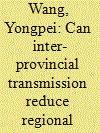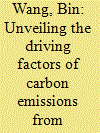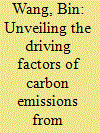|
|
|
Sort Order |
|
|
|
Items / Page
|
|
|
|
|
|
|
| Srl | Item |
| 1 |
ID:
192750


|
|
|
|
|
| Summary/Abstract |
Plagued by worsening pollution in load centers along the eastern coastal regions such as Beijing-Tianjin -Hebei, China is reducing local coal-fired power plants in those regions and relying more on inter-regional power transmission. In recent years, China has accelerated the construction of the West-East Electricity Transmission Project and planned and constructed a number of Ultra-high Voltage (UHV) transmission lines. However, how the impact of inter-regional transmission on carbon emissions needs empirical verification. This paper aims to study the carbon emission reduction effect of inter-regional transmission under nested models of the spatial econometric model for panel data. The empirical results show that although the non-dynamic spatial econometric analysis can find the carbon emission reduction effect of inter-provincial transmission, the long-term effect obtained by the dynamic spatial econometric analysis indicates that the inter-provincial transmission can bring about a slight increase in carbon emissions. The inter-provincial power transmission needs to be supported by sustainable share growth of renewable energy to achieve the targeted mitigation of carbon emissions.
|
|
|
|
|
|
|
|
|
|
|
|
|
|
|
|
| 2 |
ID:
178830


|
|
|
|
|
| Summary/Abstract |
Information and communication technology supported by the internet has become an important driving force that promotes the intelligent development of environmental governance in China. Using Chinese provincial panel data for the period 2006–2017, this study investigates whether the internet has improved China's green total factor energy efficiency (GTFEE) using a dynamic spatial Durbin model, mediation effect model and dynamic threshold panel model. The empirical results indicate that the GTFEE has a significant positive spatial correlation. Internet development can not only directly improve local GTFEE but also improve GTFEE in neighboring regions. After accounting for potential endogeneity, this conclusion is still valid. Meanwhile, internet development can indirectly improve regional GTFEE by reducing the degree of resource mismatch while enhancing GTFEE by improving regional innovation capabilities and promoting industrial structure upgrades. In addition, the regression results of the dynamic threshold model show that there is a nonlinear relationship between the influence of the internet development and GTFEE. Specifically, due to an increase in the degree of labor resource mismatch and capital resource mismatch, the impact of the internet on GTFEE has gradually decreased, and this effect has gradually increased with the improvement of regional innovation capabilities and the industrial structure.
|
|
|
|
|
|
|
|
|
|
|
|
|
|
|
|
| 3 |
ID:
176770


|
|
|
|
|
| Summary/Abstract |
The international community has reached a consensus on preventing the global climate from deterioration by stabilizing greenhouse gas concentrations in the atmosphere. Energy industry is a key field for greenhouse gas emission, and investment in the energy industry plays a crucial part in promoting the low-carbon development of China's energy industry. Energy investment can effectively break the high carbon ″lock-in effect″ of energy industry and achieve the low-carbon development of energy industry by guiding, regulating and gathering social funds into the field of cleaner production and the field of low-carbon technology. Based on the unified framework of energy, economy and environment, this article takes 30 provinces in China as the research object, and constructs a spatial econometric model to investigate the impact of energy investment and economic growth on carbon emission reduction. The results indicate that both energy investment and economic growth are responsible for the increase of China's provincial CO2 emissions, but their driving mechanisms are significantly different. Furthermore, the increase of carbon emissions in adjacent provinces will bring about the increase of local carbon emissions through spatial spillover effects. Based on these findings, the corresponding countermeasures and policy suggestions are put forward.
|
|
|
|
|
|
|
|
|
|
|
|
|
|
|
|
| 4 |
ID:
179725


|
|
|
|
|
| Summary/Abstract |
This paper takes China's pilot emission trading policy as a quasi-natural experiment to study the green innovation effect. Based on the green patent data of listed companies in China from 2000 to 2018, the spatial Durbin model was used to explain the green innovation effect of the emission trading policy on pilot areas and neighboring areas at the national level, and the heterogeneity was further discussed according to the patent types in this paper. Further, the interaction effect of the policy and government intervention was studied in this paper. The conclusions can be obtained as follows: First, the emission trading policy has a significant promotion effect on the green innovation in the pilot areas, and a significant inhibitory effect in the neighboring areas. Second, there is a patent type heterogeneity between the green invention innovation effect and the green utility model innovation effect. The emission trading policy only shows a significant spatial spillover effect in green utility model innovation. Third, a high level of government intervention will inhibit the green innovation effect. This article provides empirical evidence and policy implementations to better promote the green innovation by implementing the emission trading policy more rationally.
|
|
|
|
|
|
|
|
|
|
|
|
|
|
|
|
| 5 |
ID:
186425


|
|
|
|
|
| Summary/Abstract |
Controlling the growth of CO2 emissions has become a focus of China and improving energy efficiency is widely regarded as one of the most effective measures to reduce CO2 emissions. By constructing a dynamic comprehensive energy efficiency index, we estimated the energy efficiency of 30 provinces in China from 2001 to 2017 using the stochastic frontier analysis method. Then, we investigated the spatial effects of energy efficiency on CO2 emissions and its regional heterogeneity under geographic, economic, and social weight matrices by using the spatial Durbin model. The results indicate that the comprehensive energy efficiency of China shows a gradual improvement trend during the sample period. There exist spatial spillover effects of energy efficiency on regional CO2 reduction. Energy efficiency improvement in the eastern region shows significant spillover effect on neighboring area's CO2 reduction under the three weight matrices. The central region exhibits this spatial effect only under the weight of economic distance. However, there is no significant spillover effect in the western region. Economic factors play a greater role in the spillover effect of energy efficiency. The findings of this paper provide several important policy implications for improving energy efficiency and reducing CO2 emissions in various regions of China.
|
|
|
|
|
|
|
|
|
|
|
|
|
|
|
|
| 6 |
ID:
181466


|
|
|
|
|
| Summary/Abstract |
Analyzing the relationship between industrial resource allocation and carbon emissions from the regional level will promote cross-regional environmental coordinated governance. Based on the panel data of 30 provinces from 2007 to 2016, this paper explores the spatial distribution of industrial resource allocation, spatial autocorrelation of carbon emissions, and the relationship from a spatial econometric perspective. The results show that compared with other provinces, Jilin, Zhejiang, and Guangdong have relatively higher industrial resource allocation efficiency. The provinces with higher carbon emissions are spatially adjacent, and the provinces with lower carbon emissions are also spatially adjacent. On a national level, the improvement of industrial resource allocation can reduce carbon emissions. On a regional level, the impact of industrial resource allocation efficiency on carbon emissions is somewhat different. Industrial resource allocation can significantly reduce carbon emissions in the eastern region. However, it is not clear whether the improvement in the industrial resource allocation efficiency can reduce carbon emissions in the central, western, and northeast regions.
|
|
|
|
|
|
|
|
|
|
|
|
|
|
|
|
| 7 |
ID:
181467


|
|
|
|
|
| Summary/Abstract |
Analyzing the relationship between industrial resource allocation and carbon emissions from the regional level will promote cross-regional environmental coordinated governance. Based on the panel data of 30 provinces from 2007 to 2016, this paper explores the spatial distribution of industrial resource allocation, spatial autocorrelation of carbon emissions, and the relationship from a spatial econometric perspective. The results show that compared with other provinces, Jilin, Zhejiang, and Guangdong have relatively higher industrial resource allocation efficiency. The provinces with higher carbon emissions are spatially adjacent, and the provinces with lower carbon emissions are also spatially adjacent. On a national level, the improvement of industrial resource allocation can reduce carbon emissions. On a regional level, the impact of industrial resource allocation efficiency on carbon emissions is somewhat different. Industrial resource allocation can significantly reduce carbon emissions in the eastern region. However, it is not clear whether the improvement in the industrial resource allocation efficiency can reduce carbon emissions in the central, western, and northeast regions.
|
|
|
|
|
|
|
|
|
|
|
|
|
|
|
|
|
|
|
|
|